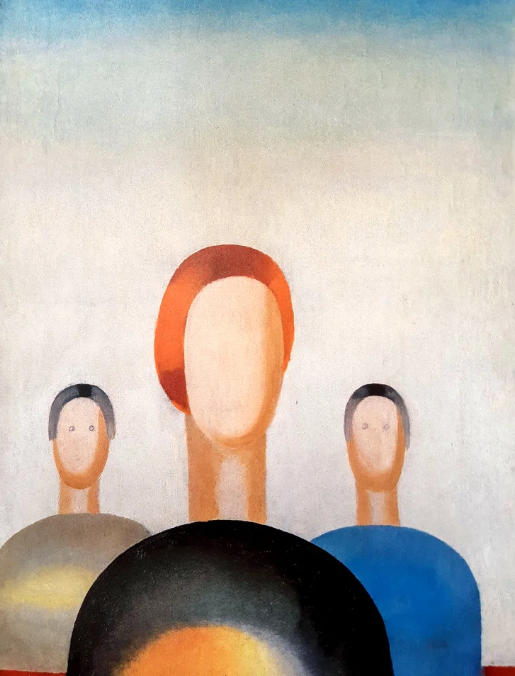There Is No “Eye” in “Art”

Pictured above is “Three Figures”,” a painting by Soviet avant-garde artist Anna Leporskaya. Leporskaya, who died in 1982, was among the Soviet Union’s most notable artists — during her career, she won the Repin State Prize, given to Russia’s top artist, and was named an Honored Artist of the Russian Soviet Federated Socialist Republic. Many of her works are on display at the Tretyakov Gallery in Moscow, which, per Wikipedia’s editors, “is considered the foremost depository of Russian fine art in the world.”
But if you haven’t heard of Leporskaya, don’t worry — you’re not alone. Neither did Alexander Vasilyev. Unfortunately for him, his ignorance of the artist, combined with a good deal of boredom and a bit of impulsivity, cost him a good amount of freedom.
In early December 2021, “Three Figures” was at the Boris Yeltsin Presidential Center in the Russian city of Yekaterinburg, on loan from the Tretyakov Gallery. Vasilyev was there, too — not as a visitor, but as a contractor. The Center hired a private firm to provide security services, and that firm hired the 63-year-old Vasilyev as a security guard. He started on or around December 7th, and apparently, didn’t find the work very fulfilling. There wasn’t a lot of crime or even disorder at his new place of work, so he just walked around the building over and over again. And when he walked by “Three Figures,” it didn’t occur to him that it was anything special — the opposite, in fact. As the New York Times reported, Vasilyev thought it was just a “children’s drawing” and told other outlets that he found the work depressing and confusing — the figures lacked humanity.
A group of nearby teenagers agreed with Vasilyev’s take and they encouraged him to do something about it. They suggested he give the figures some personality by adding a touch of his own. So he grabbed a pen and did just that. Let’s take a look.
If it’s not obvious (or given away by the title of today’s story), the two figures on the sides grew a pair of eyes — courtesy of Vasilyev.
Unfortunately, on December 7 of that year, two visitors noticed the eyes — and they, unlike Vasilyev, knew that “Three Figures” wasn’t painted by a fourth grader. Oh, and it was worth a small fortune — according to ArtNews, it was insured at a valuation of 75 million rubles (about $975,000), and of course, the eyes weren’t part of that valuation.
The good news, for the art fans out there, is that the damage from the Yeltsin Center-branded souvenir pen wasn’t very expensive. Vasilyev didn’t use a lot of pressure when making his little ink circles, and the painting itself suffered limited damage; per the BBC, it was easily restored at a cost of about 250,000 rubles (or roughly $3,500).
But there was still bad news for Vasilyev. As ArtNews reported in a follow-up story, “the Yeltsin Center filed a complaint with the police, but Yekaterinburg’s ministry of internal affairs at first declined to press charges against Vasilyev as the damage was considered ‘insignificant.’” But a few weeks later, authorities reconsidered, ultimately charging him with vandalism. In August of 2022, he was found guilty. According to ArtReview, “the court determined Vasilyev must serve 180 hours of ‘compulsory labor’ and under “psychiatric evaluation.” He is no longer employed at the Center as a security guard.
Bonus fact: While Canada is still part of the UK’s Commonwealth Realm (and therefore recognized Charles III as its king), it is an otherwise fully independent nation from the United Kingdom. The nation achieved that full level of independence in 1982 when Queen Elizabeth II signed the Canada Act, removing Great Britain’s ability to amend the Canadian Constitution. Thereafter, the Canadian government passed the Constitution Act 1982, establishing the first fully Canadian Constitution. While the Queen had no power to reject changes, she still came to Canada to sign a proclamation that the changes were accepted and now in force. She signed two copies of the proclamation; one was damaged by rain during the signing ceremony and the other was sent to the Library and Archives Canada (the equivalent of the Library of Congress in the U.S.) for safekeeping. They didn’t do a great job of that, though.
A year after the proclamation was signed, an art student named Peter Greyson visited the Archives and asked to see the document, and the archivist agreed. Greyson’s motives weren’t benign, though. Once he had access to the proclamation, Greyson, according to the Globe and Mail, “pulled a glue bottle out of his suit and poured out red paint.” He would later explain that “he had doused the document in protest of a decision to allow the United States to conduct cruise missile testing over Canada” and was sentenced to 89 months in prison for vandalism. Unlike the damage to the “Three Figures,” restoration isn’t a viable option — experts agree that removing the paint would cause further damage to the document. As seen here, the red paint splotch remains to this day.
From the Archives: When Jesus Turned into a Potato (Accidentally): Art restoration gone very, very badly.

